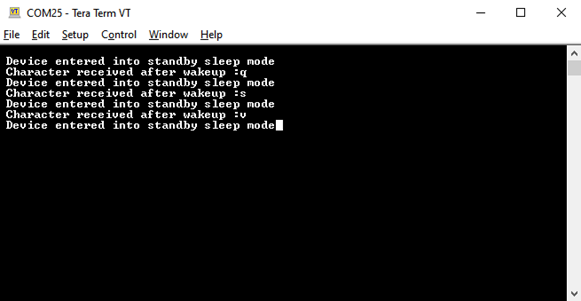3.3.11 SOF Detection and Wakeup Configuration on SAM D21 Curiosity Nano Evaluation Kit
Description
This application demonstrates the USART communication in low power modes (sleep and wakeup modes) using SAM D21 Curiosity Nano Evaluation Kit. The host (PC) sends a data to the client (SAM D21 Curiosity Nano Evaluation Kit), causing it to wake up from the sleep mode and displays the data sent by the host. Once the data is displayed, the client goes back to the sleep mode and waits for the next data to be sent by the host.
Modules/Technology Used
- Peripheral Modules
- NVMCTRL
- EVSYS
- SERCOM
- PM
Hardware Used
Software/Tools Used
This project has been verified to work with the following versions of software tools:
Refer Project Manifest present in harmony-manifest-success.yml under the project folder firmware/src/config/sam_d21_cnano.
- Refer the Release Notes to know the MPLAB X IDE and MCC Plugin version.
- Any Serial Terminal application, such as Tera Term terminal application.
Because Microchip regularly updates tools, occasionally issue(s) could be discovered while using the newer versions of the tools. If the project does not seem to work and version incompatibility is suspected. It is recommended to double-check and use the same versions that the project was tested with. To download original version of MPLAB Harmony v3 packages, refer to document How to Use the MPLAB Harmony v3 Project Manifest Feature (DS90003305).
Setup
- Connect the Type-A male to Micro-B
USB cable to Micro-B DEBUG USB port (J900) to program and debug the SAM D21 Curiosity
Nano Evaluation Kit.
Programming Hex File
The pre-built hex file can be programmed by following the below steps.
- Open MPLAB X IDE
- Close all existing projects in IDE, if any project is opened.
- Go to File -> Import -> Hex/ELF File.
- In the Import Image File
window,
- Create Prebuilt Project,
- Click the Browse button to select the prebuilt hex file.
- Select Device as ATSAMD21G17D.
- Ensure the proper tool is selected under Hardware Tool and click on Next button.
- Select Project Name and Folder,
- Select appropriate project name and folder and click on Finish button
- Create Prebuilt Project,
- In MPLAB X IDE, click on Make and Program Device button to program the device.
- Follow the steps in Running the Demo section below.
Programming/Debugging Application Project
- Open the project (sam_d21_cnano_usart_sof_wakeup\firmware\sam_d21_cnano.X) in MPLAB X IDE
- Ensure SAM D21 Curiosity Nano is selected as hardware tool to program/debug the application
- Build the code and program the device by clicking on the Make and Program button in MPLAB X IDE tool bar
- Follow the steps in Running the Demo section below
Running the Demo
- Open the Tera Term terminal applications on the PC (from the Windows Start menu by pressing the Start button).
- Set the baud rate to 9600 on the terminal.
- Reset or power cycle the device.
- When data is entered, the device wakes from sleep mode and displays the entered data.
- Below diagram shows the sample output
log displayed on command prompt.

Comments
- Reference Training Module: Getting Started with Harmony v3 Peripheral Libraries on SAM D21 MCUs
- This application demo builds and
works out of box by following the instructions above in Running the Demo
section. If the user needs to enhance/customize this application demo, should use the
MPLAB Harmony v3 Software framework. Refer links below to setup and build the
applications using MPLAB Harmony.
- How to Setup MPLAB Harmony v3 Software Development Framework (DS90003232).
- How to Build an Application by Adding a New PLIB, Driver, or Middleware to an Existing MPLAB Harmony v3 Project (DS90003253).
- How to Set up the Tools Required to Get Started with MPLAB® Harmony v3 and MCC
- Create a new MPLAB Harmony v3 project using MCC
- Update and Configure an Existing MHC-based MPLAB Harmony v3 Project to MCC-based Project
